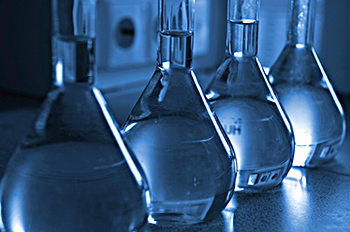
Yield & Fibre Diameter
AWTA Raw Wool's key service is the independent sampling, testing and certifying of the Yield and Fibre Diameter of greasy wool before it is sold. Prior to the measurment of Yield and Fibre Diameter, a representative sample must be obtained. A core sample is taken from each bale in a sale lot under the supervision of an AWTA sampling officer. The bale weight is recorded at the time of sampling.
Yield is the amount of clean fibre, at a standard moisture content, that is expected to be produced when a parcel of raw wool is processed. The yield may be expressed as a clean mass in kilograms and as a percentage of the mass of raw wool prior to processing.
Staple Length & Strength
One of the most important characteristics for determining the value of greasy wool is the average fibre length that will be achieved when the wool has been processed or combed into wool top. This length is known as the Hauteur (fibre length in the Wool Top). In addition, the average strength of staples is important in assessing how well the wool will perform during processing. Research has shown that Hauteur is closely correlated with the average Staple Length and Staple Strength of the greasy wool measured prior to processing.
Clean Colour
Average Yellowness is an important characteristic of wool because it is related to dyeing performance and it is not necessarily related to the colour of Greasy Wool. Considerable quantities of wool are typed as H1 (Light unscourable Colour), H2 (Medium unscourable Colour) or H3 (Heavy unscourable Colour) based purely on visual assessment of the greasy wool and are discounted in the market.
Fleece Measurement
Samples of fleece wool that are taken from individual sheep are submitted by sheep breeders and wool growers for the routine measurement of Fibre Diameter (micron) using a Laserscan instrument. This instrument provides other data in conjunction with the Fibre Diameter result, including the Coefficient of Variation of Diameter (CVD), Comfort Factor and a Fibre Curvature measurement result.
Pesticide Residues
Analysis which identifies and quantifies the residual level of lice and fly treatment chemicals in greasy wool, semi-processed wool and wool grease. The presence of heavy metals such as Arsenic can also be determined.
 |
Wool samples are prepared and blended at one of our Raw Wool Laboratories, then sent for chemical analysis to AWTA’s Agrifood Technology division. Any chemicals present are extracted from the wool using a proprietary process and their concentrations determined using state-of-the-art equipment. Tests are done in accordance with the International Wool Textile Organisation method DTM59-04. We are also looking at developing methods for detrermining residual pestcide levels in individual fleece samples. |
The major chemical groups screened include Organophosphates, Organochlorines, Synthetic Pyrethroids and specific Insect Growth Regulators (Diflubenzuron, Triflumuron & Dicyclanil). The full list of checmicals reported is shown below:
|
|
||||||||||||||||||||||
|
|
||||||||||||||||||||||
|
|||||||||||||||||||||||
|
|||||||||||||||||||||||
|
|
||||||||||||||||||||||
|
|
Find out more:
Fact Sheet - Pesticide Residue Analysis![]()
Pesticide Residue Test Request
Organochlorines (OG)
Dark & Medullated Fibre
The Dark Fibre Testing service offered by AWTA is targeted at white-wool growers who are attempting to manage contamination from exotic sheep breeds, or who wish to monitor the contamination in lots carrying a high risk of contamination.
Dark & Medullated Fibre Risk Scheme
Australian Merino wool has enjoyed a high reputation and price premium for more than one hundred years because it produced wool tops with low levels of dark and medullated fibre contamination. Recently, early and later stage processors of Australian wool have noticed increased occurrences of dark and medullated fibres in wool tops produced from Australian Merino wool.
The International Wool Textile Organisation (IWTO), through its Australian affiliate, the Federation of Australian Wool Organisations (FAWO) has initiated a program to protect the reputation of Australia's premium Merino white wool by managing the risk of dark and/or medullated fibre contamination.
Scoured Wool
Scouring is the process of preparing and washing a batch of raw sheep's wool to remove impurities such as grease, dirt and suint. AWTA Raw Wool is able to perform the certified testing of scoured and carbonised wool for Wool Base, Vegetable Matter Base and Mean Fibre Diameter.


